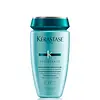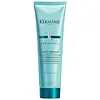What's inside
What's inside
 Benefits
Benefits

 Concerns
Concerns

 Ingredients Side-by-side
Ingredients Side-by-side

Water
Skin ConditioningSodium Laureth Sulfate
CleansingDisodium Cocoamphodiacetate
CleansingGlycol Distearate
EmollientSodium Laureth-8 Sulfate
CleansingHexylene Glycol
EmulsifyingSodium Chloride
MaskingSodium Benzoate
MaskingSodium Methylparaben
PreservativeMagnesium Laureth-8 Sulfate
CleansingMagnesium Laureth Sulfate
CleansingSodium Oleth Sulfate
CleansingHydroxypropyl Guar Hydroxypropyltrimonium Chloride
Alcohol Denat.
AntimicrobialPolyquaternium-30
Salicylic Acid
MaskingEthylparaben
PreservativeCarbomer
Emulsion StabilisingMagnesium Oleth Sulfate
CleansingAmyl Cinnamal
PerfumingBenzyl Alcohol
PerfumingHexyl Cinnamal
PerfumingMethylparaben
PreservativeLinalool
PerfumingBenzyl Salicylate
Perfuming2-Oleamido-1,3-Octadecanediol
Skin ConditioningLimonene
PerfumingCitronellol
PerfumingCetyl Alcohol
EmollientGlycerin
HumectantBehentrimonium Methosulfate
Quaternium-33
Trehalose
HumectantTamarindus Indica Seed Polysaccharide
Skin ConditioningMyrothamnus Flabellifolia Leaf Extract
EmollientCitric Acid
BufferingSodium Hydroxide
BufferingParfum
MaskingWater, Sodium Laureth Sulfate, Disodium Cocoamphodiacetate, Glycol Distearate, Sodium Laureth-8 Sulfate, Hexylene Glycol, Sodium Chloride, Sodium Benzoate, Sodium Methylparaben, Magnesium Laureth-8 Sulfate, Magnesium Laureth Sulfate, Sodium Oleth Sulfate, Hydroxypropyl Guar Hydroxypropyltrimonium Chloride, Alcohol Denat., Polyquaternium-30, Salicylic Acid, Ethylparaben, Carbomer, Magnesium Oleth Sulfate, Amyl Cinnamal, Benzyl Alcohol, Hexyl Cinnamal, Methylparaben, Linalool, Benzyl Salicylate, 2-Oleamido-1,3-Octadecanediol, Limonene, Citronellol, Cetyl Alcohol, Glycerin, Behentrimonium Methosulfate, Quaternium-33, Trehalose, Tamarindus Indica Seed Polysaccharide, Myrothamnus Flabellifolia Leaf Extract, Citric Acid, Sodium Hydroxide, Parfum
Water
Skin ConditioningCyclopentasiloxane
EmollientPropylene Glycol
HumectantDimethiconol
EmollientTriethanolamine
BufferingPhenoxyethanol
PreservativePEG/PPG-17/18 Dimethicone
EmulsifyingCarbomer
Emulsion StabilisingBehentrimonium Chloride
PreservativePolyquaternium-4
Potato Starch Modified
Hydroxypropyl Guar
Emulsion StabilisingMethylparaben
PreservativeLimonene
PerfumingAmodimethicone
Cetyl Alcohol
EmollientQuaternium-87
CleansingBehentrimonium Methosulfate
Quaternium-33
Trideceth-6
Emulsifying2-Oleamido-1,3-Octadecanediol
Skin ConditioningGeraniol
PerfumingLinalool
PerfumingGlycerin
HumectantCitronellol
PerfumingCitral
PerfumingCetrimonium Chloride
AntimicrobialTrehalose
HumectantTamarindus Indica Seed Polysaccharide
Skin ConditioningMyrothamnus Flabellifolia Leaf Extract
EmollientParfum
MaskingWater, Cyclopentasiloxane, Propylene Glycol, Dimethiconol, Triethanolamine, Phenoxyethanol, PEG/PPG-17/18 Dimethicone, Carbomer, Behentrimonium Chloride, Polyquaternium-4, Potato Starch Modified, Hydroxypropyl Guar, Methylparaben, Limonene, Amodimethicone, Cetyl Alcohol, Quaternium-87, Behentrimonium Methosulfate, Quaternium-33, Trideceth-6, 2-Oleamido-1,3-Octadecanediol, Geraniol, Linalool, Glycerin, Citronellol, Citral, Cetrimonium Chloride, Trehalose, Tamarindus Indica Seed Polysaccharide, Myrothamnus Flabellifolia Leaf Extract, Parfum
Ingredients Explained
These ingredients are found in both products.
Ingredients higher up in an ingredient list are typically present in a larger amount.
We don't have a description for 2-Oleamido-1,3-Octadecanediol yet.
Behentrimonium Methosulfate is an ammonium salt. It is mainly used to prevent static in haircare products as a surfactant.
Surfactants have differing ends: one side is hydrophilic while the other end is hydrophobic.
Surfactants also help your cleansers remove pollutants more easily from the skin.
Learn more about Behentrimonium MethosulfateCarbomer is a polymer of acrylic acid. Its main role is to create a gel consistency.
A high amount of carbomer can cause pilling or balling up of products. Don't worry, most products contain 1% or less of carbomer.
Cetyl Alcohol is a fatty alcohol. Fatty Alcohols are most often used as an emollient or to thicken a product.
Its main roles are:
Though it has "alcohol" in the name, it is not related to denatured alcohol or ethyl alcohol.
The FDA allows products labeled "alcohol-free" to have fatty alcohols.
Learn more about Cetyl AlcoholCitronellol is used to add fragrance/parfum to a product. It is often derived from plants such as roses. In fact, it can be found in many essential oils including geranium, lavender, neroli, and more. The scent of Citronellol is often described as "fresh, grassy, and citrus-like".
Since the Citronellol molecule is already unstable, Citronellol becomes irritating on the skin when exposed to air.
Citronellol is a modified terpene. Terpenes are unsaturated hydrocarbons found in plants. They make up the primary part of essential oils.
Citronellol is not able to be absorbed into deeper layers of the skin. It has low permeability,
Citronellol is also a natural insect repellent.
Learn more about CitronellolGlycerin is already naturally found in your skin. It helps moisturize and protect your skin.
A study from 2016 found glycerin to be more effective as a humectant than AHAs and hyaluronic acid.
As a humectant, it helps the skin stay hydrated by pulling moisture to your skin. The low molecular weight of glycerin allows it to pull moisture into the deeper layers of your skin.
Hydrated skin improves your skin barrier; Your skin barrier helps protect against irritants and bacteria.
Glycerin has also been found to have antimicrobial and antiviral properties. Due to these properties, glycerin is often used in wound and burn treatments.
In cosmetics, glycerin is usually derived from plants such as soybean or palm. However, it can also be sourced from animals, such as tallow or animal fat.
This ingredient is organic, colorless, odorless, and non-toxic.
Glycerin is the name for this ingredient in American English. British English uses Glycerol/Glycerine.
Learn more about GlycerinLimonene is a fragrance that adds scent and taste to a formulation.
It's found in the peel oil of citrus fruits and other plants such as lavender and eucalyptus. The scent of limonene is generally described as "sweet citrus".
Limonene acts as an antioxidant, meaning it helps neutralize free radicals.
When exposed to air, oxidized limonene may sensitize the skin. Because of this, limonene is often avoided by people with sensitive skin.
The term 'fragrance' is not regulated in many countries. In many cases, it is up to the brand to define this term. For instance, many brands choose to label themselves as "fragrance-free" because they are not using synthetic fragrances. However, their products may still contain ingredients such as essential oils that are considered a fragrance.
Learn more about LimoneneLinalool is a fragrance and helps add scent to products. It's derived from common plants such as cinnamon, mint, citrus, and lavender.
Like Limonene, this ingredient oxidizes when exposed to air. Oxidized linalool can cause allergies and skin sensitivity.
This ingredient has a scent that is floral, spicy tropical, and citrus-like.
Learn more about LinaloolMethylparaben is a preservative and is a paraben. It is used to prevent the growth of fungus, mold, and other harmful bacteria. Parabens are chemicals used as preservatives in both cosmetics and food.
Methylparaben can be synthetically created. It can also be found naturally in some fruits, such as blueberries.
Oftentimes, Methylparaben is combined with other parabens to help increase the shelf life.
The safety of Methylparaben is currently being studied. While ongoing studies are looking into the safety of parabens, the results have been very mixed. Some studies have not found Methylparaben to be harmful.
Learn more about MethylparabenWe don't have a description for Myrothamnus Flabellifolia Leaf Extract yet.
Parfum is a catch-all term for an ingredient or more that is used to give a scent to products.
Also called "fragrance", this ingredient can be a blend of hundreds of chemicals or plant oils. This means every product with "fragrance" or "parfum" in the ingredients list is a different mixture.
For instance, Habanolide is a proprietary trade name for a specific aroma chemical. When used as a fragrance ingredient in cosmetics, most aroma chemicals fall under the broad labeling category of “FRAGRANCE” or “PARFUM” according to EU and US regulations.
The term 'parfum' or 'fragrance' is not regulated in many countries. In many cases, it is up to the brand to define this term.
For instance, many brands choose to label themselves as "fragrance-free" because they are not using synthetic fragrances. However, their products may still contain ingredients such as essential oils that are considered a fragrance by INCI standards.
One example is Calendula flower extract. Calendula is an essential oil that still imparts a scent or 'fragrance'.
Depending on the blend, the ingredients in the mixture can cause allergies and sensitivities on the skin. Some ingredients that are known EU allergens include linalool and citronellol.
Parfum can also be used to mask or cover an unpleasant scent.
The bottom line is: not all fragrances/parfum/ingredients are created equally. If you are worried about fragrances, we recommend taking a closer look at an ingredient. And of course, we always recommend speaking with a professional.
Learn more about ParfumWe don't have a description for Quaternium-33 yet.
We don't have a description for Tamarindus Indica Seed Polysaccharide yet.
Trehalose is a disaccharide made of two glucose molecules (glucose is sugar!). Trehalose is used to help moisturize skin. It also has antioxidant properties.
As a humectant, trehalose helps draw moisture from the air to your skin. This helps keep your skin hydrated.
Due to its antioxidant properties, trehalose may help with signs of aging. Antioxidants help fight free-radical molecules, unstable molecules that may damage your skin.
In medicine, trehalose and hyaluronic acid are used to help treat dry eyes.
Some animals, plants, and bacteria create trehalose as a source of energy to survive freeze or lack of water.
Learn more about TrehaloseWater. It's the most common cosmetic ingredient of all. You'll usually see it at the top of ingredient lists, meaning that it makes up the largest part of the product.
So why is it so popular? Water most often acts as a solvent - this means that it helps dissolve other ingredients into the formulation.
You'll also recognize water as that liquid we all need to stay alive. If you see this, drink a glass of water. Stay hydrated!
Learn more about Water